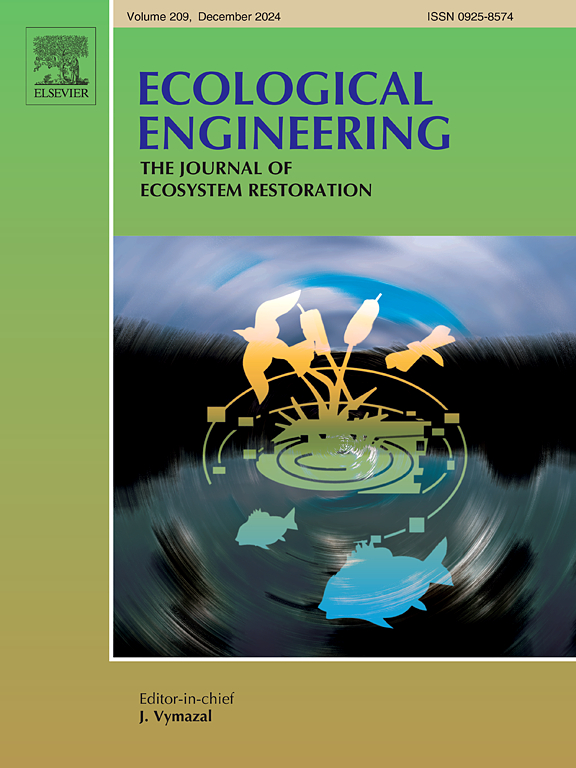利用生态工程岩石池增强人工海岸线上的生物多样性:来自波斯湾和阿曼湾的证据
IF 4.1
2区 环境科学与生态学
Q1 ECOLOGY
引用次数: 0
摘要
沿海城市化和气候变化正在推动世界范围内人工海岸结构的迅速扩张,往往以自然栖息地和生物多样性为代价。生态工程方法为减轻这些负面影响提供了有希望的解决方案,但在波斯湾和阿曼湾,这些地区经历了极端的环境条件和密集的沿海开发,在很大程度上仍未被探索。在这项研究中,我们在霍尔木兹海峡和阿曼湾的三个地点评估了人工基础设施中包含的挡水结构(岩石池)的生态有效性。在一年多的时间里,对41个保水结构进行了月度监测,鉴定出25个分类群,包括腹足类、多毛类、藤壶类和其他潮间带物种。与自然地表相比,岩石池显著提高了物种丰富度和丰度,当地环境条件影响丰度格局。重复测量方差分析证实了显著的时间差异,而PERMANOVA分析显示了不同地点之间群落结构的明显差异。值得注意的是,本地物种占主导地位,这表明即使在高度紧张的条件下,生态工程结构也可以促进本地生物多样性。我们的研究结果表明,将岩石池整合到沿海基础设施中提供了必要的微栖息地,可以缓冲环境压力,增加物种多样性,并有助于生态系统的恢复。这项研究代表了海洋生态工程在波斯湾和阿曼湾的首批实证应用之一,为在干旱和热带环境中制定更有利于生物多样性的沿海发展战略提供了重要的经验教训。本文章由计算机程序翻译,如有差异,请以英文原文为准。
Enhancing biodiversity on artificial coastlines with eco-engineered rock pools: Evidence from the Persian Gulf and Gulf of Oman
Coastal urbanization and climate change are driving the rapid expansion of artificial coastal structures worldwide, often at the cost of natural habitats and biodiversity. Eco-engineering approaches offer promising solutions to mitigate these negative impacts, yet remain largely unexplored in the Persian Gulf and Gulf of Oman — regions experiencing both extreme environmental conditions and intensive coastal development. In this study, we assessed the ecological effectiveness of water-retaining structures (rock pools) incorporated into artificial infrastructures at three locations across the Strait of Hormuz and Gulf of Oman. Monthly monitoring of 41 water-retaining structures over a year resulted in the identification of 25 taxa, including gastropods, polychaetes, barnacles, and other intertidal species. Rock pools significantly enhanced species richness and abundance compared to emergent surfaces, with local environmental conditions influencing abundance patterns. Repeated measures ANOVA confirmed significant temporal variation, and PERMANOVA analyses revealed clear differences in community structure among locations. Notably, native species dominated the assemblages, suggesting that eco-engineered structures can promote native biodiversity even under highly stressful conditions. Our findings show that integrating rock pools into coastal infrastructure offers essential microhabitats that buffer environmental stressors, increase species diversity, and contribute to ecosystem resilience. This study represents one of the first empirical applications of marine eco-engineering in the Persian Gulf and the Gulf of Oman, providing important lessons for strategies aimed at more biodiversity-friendly coastal development in arid and tropical environments.
求助全文
通过发布文献求助,成功后即可免费获取论文全文。
去求助
来源期刊

Ecological Engineering
环境科学-工程:环境
CiteScore
8.00
自引率
5.30%
发文量
293
审稿时长
57 days
期刊介绍:
Ecological engineering has been defined as the design of ecosystems for the mutual benefit of humans and nature. The journal is meant for ecologists who, because of their research interests or occupation, are involved in designing, monitoring, or restoring ecosystems, and can serve as a bridge between ecologists and engineers.
Specific topics covered in the journal include: habitat reconstruction; ecotechnology; synthetic ecology; bioengineering; restoration ecology; ecology conservation; ecosystem rehabilitation; stream and river restoration; reclamation ecology; non-renewable resource conservation. Descriptions of specific applications of ecological engineering are acceptable only when situated within context of adding novelty to current research and emphasizing ecosystem restoration. We do not accept purely descriptive reports on ecosystem structures (such as vegetation surveys), purely physical assessment of materials that can be used for ecological restoration, small-model studies carried out in the laboratory or greenhouse with artificial (waste)water or crop studies, or case studies on conventional wastewater treatment and eutrophication that do not offer an ecosystem restoration approach within the paper.
 求助内容:
求助内容: 应助结果提醒方式:
应助结果提醒方式:


